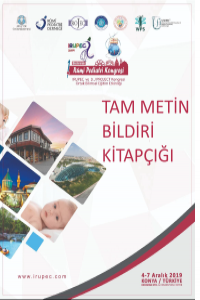Abstract
References
- References 1- Montgomery RR, Scott JP. Platelet and Blood Vessel Diseases. Behram RE, Kliegman, Jenson HB (editors). Nelson Textbook of Pediatrics. 17th Edition, Philadelphia; Saunders, 2004;1670-71. 2- Lowe EJ, Buchanan GR. Idiopathic thrombocytopenic purpura diagnosed during the second decade of life. J Pediatr 2002;141:253-58. 3- Ballem PJ, Segal GM, Stratton JR, Gernsheimer T, Adanson JW, Slichtee SJ. Mechanisims of thrombocytopenia in chronic autoimmune thrombocytopenic purpura. Evidence of both impaired platelet production and increased platelet clearance. J Clin Invest 1987;80:33-40. 4- Dilber C. İdiopatik Trombositopenik Purpura. Türkiye Klinikleri Pediatrik Bilimler Pediatrik Hematoloji Özel sayısı 2005;1:48-51. 5- Wentworth PJ, Jones LH, Wentworth AD, et al. Antibody catalysis of oxidation of water. Science 2001;293:1806-11. 6- Provan D, Newland AC. Primary immune thrombocytopenia. In: Hoffbrand AV, Catovsky D, Tuddenham E, Green AR, editors. Postgraduate Haematology. 6th ed. London: Wiley-Blackell; 2011. p. 928-39. 7- Osborn LM, Neunert CE. Management of newly diagnosed immune thrombocytopenia: can we change outcomes? Blood Adv 2017; 1(24): 2295-301. 8- Polat G, Tamer L, Tanrıverdi K, Gürkan E, Baslamıslı F, Atık U. Levels of malondialdehyde, glutathione and ascorbic acid in idiopathic thrombocytopenic purpura. East Afr Med J 2002;79:446-49. 9- Akbayram S, Doğan M, Akgün C, et al. The association of oxidant status and antioxidant capacity in children with acute and chronic ITP. J Pediatr Hematol Oncol. 2010 May;32(4):277-81.
The Oxidative Stress And Antioxidant Status Childhood With İmmune Thrombocytopenic Purpura
Abstract
The most common cause of acute onset thrombocytopenia in a healthy child is acute immune thrombocytopenic purpura (ITP). Thrombocytopenia is defined as a platelet count below 150x109 / L (1). Immune thrombocytopenic purpura is an autoimmune disease characterized by immune-mediated platelet destruction in the reticuloendothelial system (RES) (2). Other mechanisms that have been suggested to be responsible include impaired platelet production (3), complement-dependent mechanism thrombolysis (4), and antibody-dependent oxidant product hydrogen peroxide causing cellular damage (5).
Approximately 75-80% of the clinical cases of immune thrombocytopenic purpura have been classifiied as acute (self-limiting within six months) and 20-25% as chronic (lasting more than six months) (6)
The aim of the treatment is to inhibit the development of antibodies against platelets by suppressing the immune system and stop the breakdown of platelets in the spleen. Corticosteroids, intravenous immunoglobulin (IVIG), anti-D immunoglobulin and rituximab can be used in the treatment (7). High dose MP or IVIG is preferred as the initial treatment for childhood ITP. Since there is no difference in success rates in treatment, the choice is made on the basis of costs and side effects.
Oxidative damage plays a role in the pathogenesis of autoimmune diseases. Oxidative stress and free radicals have been suggested to be responsible for the pathogenesis and prognosis of ITP. Increased lipid peroxidation and decreased antioxidant capacity in ITP may play a significant role on antibodies bound to membrane lipids and platelet destruction (8).
In the literature, there is little information about oxidative stress and antioxidant defense mechanism in ITP (8). The aim of this study is to investigate the effects of oxidative stress level and different treatment options on antioxidant capacity in acute and chronic ITP and to show that whether the disease would be acute or chronic type can be predicted and the most appropriate choice of treatment can be defined by depending on the oxidative stress index (OSI) obtained during the diagnosis phase.
Keywords
References
- References 1- Montgomery RR, Scott JP. Platelet and Blood Vessel Diseases. Behram RE, Kliegman, Jenson HB (editors). Nelson Textbook of Pediatrics. 17th Edition, Philadelphia; Saunders, 2004;1670-71. 2- Lowe EJ, Buchanan GR. Idiopathic thrombocytopenic purpura diagnosed during the second decade of life. J Pediatr 2002;141:253-58. 3- Ballem PJ, Segal GM, Stratton JR, Gernsheimer T, Adanson JW, Slichtee SJ. Mechanisims of thrombocytopenia in chronic autoimmune thrombocytopenic purpura. Evidence of both impaired platelet production and increased platelet clearance. J Clin Invest 1987;80:33-40. 4- Dilber C. İdiopatik Trombositopenik Purpura. Türkiye Klinikleri Pediatrik Bilimler Pediatrik Hematoloji Özel sayısı 2005;1:48-51. 5- Wentworth PJ, Jones LH, Wentworth AD, et al. Antibody catalysis of oxidation of water. Science 2001;293:1806-11. 6- Provan D, Newland AC. Primary immune thrombocytopenia. In: Hoffbrand AV, Catovsky D, Tuddenham E, Green AR, editors. Postgraduate Haematology. 6th ed. London: Wiley-Blackell; 2011. p. 928-39. 7- Osborn LM, Neunert CE. Management of newly diagnosed immune thrombocytopenia: can we change outcomes? Blood Adv 2017; 1(24): 2295-301. 8- Polat G, Tamer L, Tanrıverdi K, Gürkan E, Baslamıslı F, Atık U. Levels of malondialdehyde, glutathione and ascorbic acid in idiopathic thrombocytopenic purpura. East Afr Med J 2002;79:446-49. 9- Akbayram S, Doğan M, Akgün C, et al. The association of oxidant status and antioxidant capacity in children with acute and chronic ITP. J Pediatr Hematol Oncol. 2010 May;32(4):277-81.
Details
| Primary Language | English |
|---|---|
| Subjects | Health Care Administration |
| Journal Section | Congress Proceedings |
| Authors | |
| Publication Date | December 10, 2019 |
| Acceptance Date | January 16, 2020 |
| Published in Issue | Year 2019 Volume: 7 Issue: Ek - IRUPEC 2019 Kongresi Tam Metin Bildirileri |

